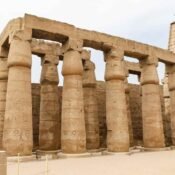
Valley of the Queens
The Valley of the Queens appears to be a sun-drenched, rocky valley with simple stone gateways leading to the burial area, where tombs have been uncovered. The remains of the pharaohs’ wives were buried in ancient Egypt.
Where exactly is the Queens Valley?
It is located in Luxor, the Valley of the Queens, which, like the Valley of the Kings, is an Egyptian burial ground where over 90 tombs have been unearthed during excavations that are still ongoing today.
What is the purpose of the Valley of the Queens?
The Valley of the Queens was designed as a burial ground for ancient Egyptian queens, but it was also used to bury princes, princesses, and other aristocrats.
The ancient Egyptians believed in an afterlife, and those who earned it would have endless life if all rituals were followed. Pharaohs and queens were buried with their treasures, clothing, and basic requirements such as food and drink because they felt their things would be required to enjoy the afterlife. Keeping their riches and valuables safe is critical, thus when building the Queen’s Valley burial, careful consideration was given to how to build the burial ground in a discreet manner to protect it. It protects the mummies from thieves and their belongings intact. once they wake up to eternal life.
The Valley of the Queens strategy is similar to that of the Valley of the Kings; the goal here is to conceal the tomb entrances, making them untargetable. However, the Valley of the Queen’s builders were unable to safeguard the Queen’s riches and goods. Although some of the decorations are still surprisingly well kept, when Schiaparelli discovered the graves in 1904, the valuables and goods were gone.
When was the Valley of the Queens constructed?
Queens and pharaohs’ wives were buried in the same tomb as their husbands in ancient Egypt, which altered at some point, explaining the creation of two valleys known as the Valley of the Queens and the Valley of the Kings.
The Valley of the Queens served as a burial ground from the 12th through the 19th and 20th Dynasties, beginning with the tomb of Princess Ahmose, daughter of King Seqenenre and Queen Sitdjehuti, which dates from the reign of King Thutmose I.
Recent Posts
Luxor day tour: Most Illuminated Temples
Discover Luxury Nile Cruises
Designing the Perfect Itinerary for Your Nile Cruise




